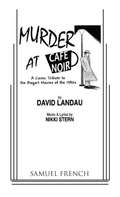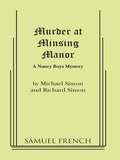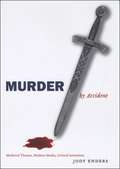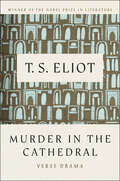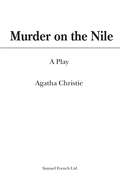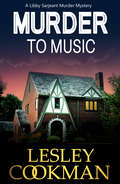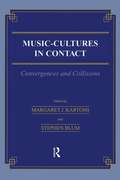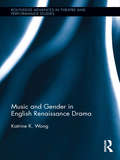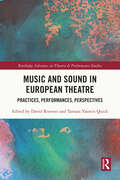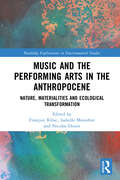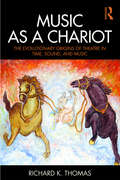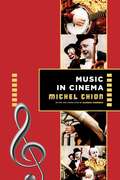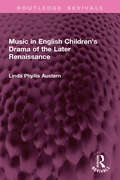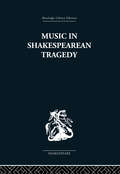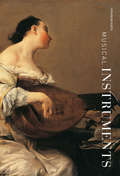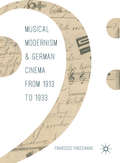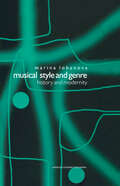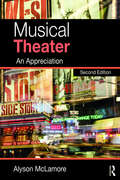- Table View
- List View
Murder at Cafe Noir
by David Landau Nikki SternMystery / 4m, 3f / The most popular mystery dinner show in the country, Murder at Cafe Noir has enjoyed weekly productions coast to coast since its premiere in 1989. This forties detective story come to life features Rick Archer, P.I., out to find a curvaceous runaway on the forgotten island of Mustique, a place stuck in a black and white era. The owner of the Cafe Noir has washed ashore, murdered, and Rick's quarry was the last person seen with him. He employs his hard boiled talents to find the killer. Was it the French madame and club manager, the voodoo priestess, the shyster British attorney, the black marketeer or the femme fatale? The audience votes twice on what they want Rick to do next and these decisions change the flow of this comic tribute to the Bogart era.
Murder at Minsing Manor
by Michael SimonAdvanced Groups Mystery/Farce / 8 m, 2 f (with doubling) / 1 set / The first Ridiculous Theatrical Company production by outside playwrights brims with irreverent wit. Horror show host Marius Mintsingue is killed on the air, much to the dismay of would be detectives Buddy and Bob (pubescent boys played by women) who are his biggest fans. Mintsingue's cross dressing lover, finds herself the head of Mintsingue Manor, a Gothic mansion in postwar suburbia. While the murderer stalks, she struggles to support the household without implicating herself by collecting on the will or insurance, to protect Mintsingue's live in protege (a half man/half woman sideshow veteran) and to keep at bay the forces of authority. Bob and Buddy's sleuthing unintentionally brings this mystery to its shattering conclusion. / "Happy, dizzy and very pleasurable." N.Y. Times.
Murder by Accident: Medieval Theater, Modern Media, Critical Intentions
by Jody EndersOver fifty years ago, it became unfashionable--even forbidden--for students of literature to talk about an author's intentions for a given work. InMurder by Accident, Jody Enders boldly resurrects the long-disgraced concept of intentionality, especially as it relates to the theater. Drawing on four fascinating medieval events in which a theatrical performance precipitated deadly consequences, Enders contends that the marginalization of intention in critical discourse is a mirror for the marginalization--and misunderstanding--of theater. Murder by Accidentrevisits the legal, moral, ethical, and aesthetic limits of the living arts of the past, pairing them with examples from the present, whether they be reality television, snuff films, the "accidental" live broadcast of a suicide on a Los Angeles freeway, or an actor who jokingly fired a stage revolver at his temple, causing his eventual death. This book will force scholars and students to rethink their assumptions about theory, intention, and performance, both past and present.
Murder in Green Meadows
by Douglas PostTHE STORY: Thomas Devereaux, a successful architect and local contractor, and his beautiful wife, Joan, have just moved into their dream house in the quiet suburban town of Green Meadows when they are visited by their new neighbors, Carolyn and Jeff.
Murder in the Cathedral: Verse Drama
by T. S. EliotT. S. Eliot's most famous drama, a retelling of the murder of the archbishop of CanterburyMurder in the Cathedral, written for the Canterbury Festival in 1935, was one of T. S. Eliot’s first dramatic achievements, and it remains one of the great plays of the century. It takes as its subject matter the martyrdom of Thomas Becket, Archbishop of Canterbury, depicting the events that led to his assassination, in his own cathedral church, by the knights of Henry II in 1170. Like Greek drama, the play’s theme and form are rooted in religion, ritual purgation and renewal, and it was this return to the earliest sources of drama that brought poetry triumphantly back to the English stage at the time."The theatre is enriched by this poetic play of grave beauty and momentous decision." —The New York Times
Murder on Reserve
by Thomas HischakMystery / 4m, 5f, 1 extra / Interior / In the small midwestern town of Sanford, the impossible has happened: someone has strangled crotchety old Faulkner Seaton in the reference section of the local library while the dusty old landmark was open. Most puzzling of all is the fact that nobody in the place saw or heard a thing. Inspector Trigg and his assistant, Lt. Elizabeth Roberts, are brought in from St. Louis to solve the mystery, only to discover the most unlikely collection of suspects: a meticulous librarian, his repressed assistant, a talkative small time speculator, a sweet high school girl, an elderly hypochondriac, a cynical library worker and a colorful drifter. It develops that old Seaton had stumbled into something important in the reference section and a missing book becomes the only clue. Trigg and Roberts set a trap to catch the murderer that results in a thrilling and revealing conclusion. Vivid characters and a plot that keeps the audience guessing make this whodunit an enjoyable romp for any theatre group.
Murder on the Nile
by Agatha ChristieDrama, 8m,5f, Interior Set. Simon Mostyn has recently married Kay Ridgeway, a rich woman, having thrown over his former lover Jacqueline. The couple are on their honeymoon on a paddle steamer on the Nile, accompanied by a bevy of memorable characters. Among those present are Canon Pennefather, Kay's guardian, and Jacqueline, who has been dogging their footsteps all through the honeymoon. During the voyage Jacqueline works herself into a state of hysteria and shoots at Simon, wounding him in the knee. A few moments later Kay is found shot in her bunk. By the time the boat reaches its destination, Canon Pennefather has laid bare an audacious conspiracy and has made sure the criminals shall not go free.
Murder to Music: A Libby Sarjeant Murder Mystery (A Libby Sarjeant Murder Mystery Series #8)
by Lesley Cookman'With fascinating characters and an intriguing plot, this is a real page turner' KATIE FFORDE praise for the seriesAn addictive and unputdownable crime mystery novel perfect for fans of Agatha Christie, Dorothy L. Sayers, Faith Martin, J.R. Ellis, LJ Ross, Miss Marple and Midsummer Murders!Lesley Cookman's bestselling series featuring amateur sleuth Libby Sarjeant is back for its eighth instalment!Amateur detective Libby Sarjeant and psychic investigator Fran Castle are invited to look into a house that is reputedly haunted by a seemingly musical ghost. For once, Libby can be as nosy as she likes without being accused of getting in the way of a police investigation.However, when they unearth 50-year-old graves in the gardens, the police are bound to cramp their style.Someone alive today doesn't want them interfering either, and their lives are in danger as they try to unravel the mystery of their Debussy playing ghost._____________________________________________________ Praise for the bestselling series:'I could not put down.... Would recommend this series to everyone' ***** Reader review'...if you miss the good old days of Agatha Christie and Dorothy L Sayers then why not give Lesley Cookman's excellent books a go' ***** Reader review'I love Libby Sarjeant and have read all of the books, which I will read again. All the characters are believable and the plots are good' ***** Reader review'A great series of books that I can't put down. Thank you' ***** Reader review 'A great book full of twists but I really like the relationships and friendships that are forming over each book' ***** Reader review
Murder to Music: A Libby Sarjeant Murder Mystery (A\libby Sarjeant Murder Mystery Ser. #8)
by Lesley Cookman'With fascinating characters and an intriguing plot, this is a real page turner' KATIE FFORDE praise for the seriesAn addictive and unputdownable crime mystery novel perfect for fans of Agatha Christie, Dorothy L. Sayers, Faith Martin, J.R. Ellis, LJ Ross, Miss Marple and Midsummer Murders!Lesley Cookman's bestselling series featuring amateur sleuth Libby Sarjeant is back for its eighth instalment!Amateur detective Libby Sarjeant and psychic investigator Fran Castle are invited to look into a house that is reputedly haunted by a seemingly musical ghost. For once, Libby can be as nosy as she likes without being accused of getting in the way of a police investigation.However, when they unearth 50-year-old graves in the gardens, the police are bound to cramp their style.Someone alive today doesn't want them interfering either, and their lives are in danger as they try to unravel the mystery of their Debussy playing ghost._____________________________________________________ Praise for the bestselling series:'I could not put down.... Would recommend this series to everyone' ***** Reader review'...if you miss the good old days of Agatha Christie and Dorothy L Sayers then why not give Lesley Cookman's excellent books a go' ***** Reader review'I love Libby Sarjeant and have read all of the books, which I will read again. All the characters are believable and the plots are good' ***** Reader review'A great series of books that I can't put down. Thank you' ***** Reader review 'A great book full of twists but I really like the relationships and friendships that are forming over each book' ***** Reader review
Murderous Crossing
by David LandauFull Length / Comedic Mystery / 4m, 3f / Interior The year is 1923 and audience members are passengers on board the HMS Victoria as it crosses the English Channel. The famous Inspector Clurrot has tracked down a homicidal mastermind hiding out on board. Meanwhile, the ship is the vessel of matrimony for the Contessa Follette and John D. Rothchild - a marriage encouraged through financial need and murderous greed. But not everything is as it seems, and it turns out that the English Channel isn't the only thing being crossed. Audience members are recruited to stand in for the best man, bridesmaid, mother of the groom, and father of the bride in this Agatha Christie style comic mystery.
Music \= Cultures in Contact: Convergences and Collisions (Musicology #16)
by Margaret J. Kartomi Stephen BlumFirst Published in 1995. Routledge is an imprint of Taylor & Francis, an informa company.
Music and Gender in English Renaissance Drama (Routledge Advances in Theatre & Performance Studies)
by Katrine K. WongThis book offers a survey of how female and male characters in English Renaissance theatre participated and interacted in musical activities, both inside and outside the contemporary societal decorum. Wong’s analysis broadens our understanding of the general theatrical representation of music, or musical dramaturgy, and complicates the current discussion of musical portrayal and construction of gender during this period. Wong discusses dramaturgical meanings of music and its association with gender, love, and erotomania in Renaissance plays. The negotiation between the dichotomous qualities of the heavenly and the demonic finds extensive application in recent studies of music in early modern English plays. However, while ideological dualities identified in music in traditional Renaissance thinking may seem unequivocal, various musical representations of characters and situations in early modern drama would prove otherwise. Wong, building upon the conventional model of binarism, explores how playwrights created their musical characters and scenarios according to the received cultural use and perception of music, and, at the same time, experimented with the multivalent meanings and significance embodied in theatrical music.
Music and Sound in European Theatre: Practices, Performances, Perspectives (Routledge Advances in Theatre & Performance Studies)
by David Roesner Tamara Yasmin QuickThe need for a research volume on European theatre music and sound is almost self-evident.Musical and sonic practices have been an integral part of theatre ever since the artform was first established 2,500 years ago: not just in subsequent genres that are explicitly driven by music, such as opera, operetta, ballet, or musical theatre, but in all kinds of theatrical forms and conventions. Conversely, academic recognition of the role of theatre music, its aesthetics, creative processes, authorships, traditions, and innovations is still insufficient. This volume unites experts from different disciplines and backgrounds to make a significant contribution to the much-needed discourse on theatre music. The term itself is a shapeshifter that signifies different phenomena at different times: the book thus deliberately casts a wide net to explore both the highly contextual terminologies and the many ways in which different times and cultures understand ‘theatre music’. By treating theatre music as a practice, focusing on its role in creating and watching performances, the book appeals to a wide range of readerships: researchers and students of all levels, journalists, audiences, and practitioners.It will be useful to universities and conservatoires alike and relevant for many disciplines in the humanities.
Music and the Performing Arts in the Anthropocene: Nature, Materialities and Ecological Transformation (Routledge Explorations in Environmental Studies)
by François Ribac Isabelle Moindrot Nicolas DoninMusic and the Performing Arts in the Anthropocene offers a series of thought-provoking chapters about music and the performing arts viewed from current Anthropocene-aware perspectives. From the use of gas, water and air in 19th-century stage practices to the ecology of musical instruments and sound reproduction technologies, waste and carbon print in experimental music and theatrical production, knowledge of precariousness and empowerment through music in a changing world, each chapter aims at highlighting an issue that has always been here but never looked at thoroughly, due to the divides and hierarchies of the modern cosmogony.Gathering 16 scholars from a variety of disciplinary backgrounds (history of literature, opera and theatre studies, musicology, sound studies, sociology, information science, etc.), this volume reflects on the relationships between the performing arts, music and environmental issues. It also explores a number of tools for changes and sketches how we will understand the arts, their history and their future beyond ecocriticism.This book will be of great interest to students and scholars in the humanities and social sciences, as well as a broader readership involved in art and environment policies.
Music as a Chariot: The Evolutionary Origins of Theatre in Time, Sound, and Music
by Richard K. ThomasMusic as a Chariot offers a multidisciplinary perspective whose primary proposition is that theatre is a type of music. Understanding how music enables the theatre experience helps to shape our entire approach to the performing arts. Beginning with a discussion on the origin and nature of time, the author takes us on an evolutionary journey to discover how music, language and mimesis co-evolved, eventually coming together to produce the complex way we experience theatre. The book integrates the evolutionary neuroscience of the human brain into this journey, offering practical implications and applications for the auditory expression of this concept—namely the fundamental techniques artists use to create sound scores for theatre. With contributions from directors, playwrights, actors and designers, Music as a Chariot explores the use of music to carry ideas into the human soul—a concept that extends beyond the theatrical to include film, video gaming, dance, or anywhere art is manipulated in time.
Music in Cinema (Film and Culture Series)
by Michel ChionMichel Chion is renowned for his explorations of the significance of frequently overlooked elements of cinema, particularly the role of sound. In this inventive and inviting book, Chion considers how cinema has deployed music. He shows how music and film not only complement but also transform each other.The first section of the book examines film music in historical perspective, and the second section addresses the theoretical implications of the crossover between art forms. Chion discusses a vast variety of films across eras, genres, and continents, embracing all the different genres of music that filmmakers have used to tell their stories. Beginning with live accompaniment of silent films in early movie houses, the book analyzes Al Jolson’s performance in The Jazz Singer, the zither in The Third Man, Godard’s patchwork sound editing, the synthesizer welcoming the flying saucer in Close Encounters of the Third Kind, and the Kinshasa orchestra in Felicité, among many more. Chion considers both original scores and incorporation of preexisting works, including the use and reuse of particular composers across cinematic traditions, the introduction of popular music such as jazz and rock, and directors’ attraction to atonal and dissonant music as well as musique concrète, of which he is a composer.Wide-ranging and original, Music in Cinema offers a welcoming overview for students and general readers as well as refreshingly new and valuable perspectives for film scholars.
Music in English Children's Drama of the Later Renaissance (Routledge Revivals)
by Linda Phyllis AusternOriginally published in 1992, Music in English Children’s Drama of the Later Renaissance is the first book-length study to examine the Elizabethan and Jacobean children’s drama, not only from a musicological perspective, but also drawing on the histories of literature, culture, and the theater. It gives the children’s companies new historical significance, showing that they were an integral and ultimately influential part of the London theatrical world. These companies originated important features of later drama, such as music before and between acts, and the exploitation of different timbres for specific effects.Those interested in music history, English literature, theater history, and cultural history will find this a comprehensive and fascinating study. Of special note are the appendices, which offer a unique and important reference source by providing the only definitive list of the plays and songs used by the children.
Music in Shakespearean Tragedy
by F W SternfeldFirst published in 1963. When originally published this book was the first to treat at full length the contribution which music makes to Shakespeare's great tragedies, among them Hamlet, Othello, and King Lear. Here the playwright's practices are studied in conjunction with those of his contemporaries: Marlowe and Jonson, Marston and Chapman. From these comparative assessments there emerges the method that is peculiar to Shakespeare: the employment of song and instrumental music to a degree hitherto unknown, and their use as an integral part of the dramatic structure.
Music in the Shadows: Noir Musical Films
by Sheri Chinen BiesenSome musical films use film noir style and jazz to reveal the dark side of fame and the American Dream.Smoke. Shadows. Moody strains of jazz. Welcome to the world of "noir musical" films, where tormented antiheroes and hard-boiled musicians battle obsession and struggle with their music and ill-fated love triangles. Sultry divas dance and sing the blues in shrouded nightclubs. Romantic intrigue clashes with backstage careers. In her pioneering study, Music in the Shadows, film noir expert Sheri Chinen Biesen explores musical films that use film noir style and bluesy strains of jazz to inhabit a disturbing underworld and reveal the dark side of fame and the American Dream. While noir musical films like A Star Is Born include musical performances, their bleak tone and expressionistic aesthetic more closely resemble the visual style of film noir. Their narratives unfold behind a stark noir lens: distorted, erratic angles and imbalanced hand-held shots allow the audience to experience a tortured, disillusioned perspective.While many musicals glamorize the quest for the spotlight in Hollywood's star factory, brooding noir musical films such as Blues in the Night, Gilda, The Red Shoes, West Side Story, and Round Midnight stretch the boundaries of film noir and the musical as film genres collide. Deep shadows, dim lighting, and visual composition evoke moodiness, cynicism, pessimism, and subjective psychological points of view.As in her earlier study of film noir, Blackout: World War II and the Origins of Film Noir, Biesen draws on extensive primary research in studio archives to situate her examination within a historical, industrial, and cultural context.
Musical Comedy in America: From The Black Crook to South Pacific, From The King & I to Sweeney Todd
by Cecil A. Smith Glenn LittonFirst Published in 1987. Routledge is an imprint of Taylor & Francis, an informa company.
Musical Instruments
by Darcy KuronenEnhanced with twenty-five audio and twenty-three video clips of expert musicians performing on rare and historical instruments, this e-book edition of Musical Instruments brings the world-renowned collection at the Museum of Fine Arts, Boston, to life. Musical instruments are among the most meaningful artifacts produced by humankind, a marriage of technology, artistry, symbolism, religion, and entertainment. This title in the MFA Highlights series presents more than a hundred examples, spanning a breadth of centuries and cultures, to invite readers to experience a brilliant array of instruments as producers of both aural and visual delight. The pieces included here - which range from an ancient Greek trumpet to a modern lap steel guitar, and from earthenware panpipes to the complex Indonesian gamelan - are remarkable not only for the myriad sounds they produce, but also for their varied and often extraordinarily beautiful appearance. Musical Instruments offers a vivid encounter with a rich collection, enhanced to provide an accessible and fascinating introduction to the artistry and significance of musical instruments around the world.ABOUT THE AUTHORDarcy Kuronen is Department Head and Pappalardo Curator of Musical Instruments at the Museum of Fine Arts, Boston.
Musical Instruments
by Darcy KuronenEnhanced with twenty-five audio and twenty-three video clips of expert musicians performing on rare and historical instruments, this e-book edition of Musical Instruments brings the world-renowned collection at the Museum of Fine Arts, Boston, to life. Musical instruments are among the most meaningful artifacts produced by humankind, a marriage of technology, artistry, symbolism, religion, and entertainment. This title in the MFA Highlights series presents more than a hundred examples, spanning a breadth of centuries and cultures, to invite readers to experience a brilliant array of instruments as producers of both aural and visual delight. The pieces included here - which range from an ancient Greek trumpet to a modern lap steel guitar, and from earthenware panpipes to the complex Indonesian gamelan - are remarkable not only for the myriad sounds they produce, but also for their varied and often extraordinarily beautiful appearance. Musical Instruments offers a vivid encounter with a rich collection, enhanced to provide an accessible and fascinating introduction to the artistry and significance of musical instruments around the world.ABOUT THE AUTHORDarcy Kuronen is Department Head and Pappalardo Curator of Musical Instruments at the Museum of Fine Arts, Boston.
Musical Modernism and German Cinema from 1913 to 1933
by Francesco FinocchiaroThis book investigates the relationship between musical Modernism and German cinema. It paves the way for anunorthodox path of research, one which has been little explored up until now. The main figures of musical Modernism, from Alban Berg to Paul Hindemith, and from Richard Strauss to Kurt Weill, actually had a significant relationship with cinema. True, it was a complex and contradictory relationship in which cinema often emerged more as an aesthetic point of reference than an objective reality; nonetheless, the reception of the language and aesthetic of cinema had significant influence on the domain of music. Between 1913 and 1933, Modernist composers' exploration of cinema reached such a degree of pervasiveness and consistency as to become a true aesthetic paradigm, a paradigm that sat at the very heart of the Modernist project. In this insightful volume, Finocchiaro shows that the creative confrontation with the avant-garde medium par excellence can be regarded as a vector of musical Modernism: a new aesthetic paradigm for the very process - of deliberate misinterpretation, creative revisionism, and sometimes even intentional subversion of the Classic-Romantic tradition - which realized the "dream of Otherness" of the Modernist generation.
Musical Style and Genre: History and Modernity
by Marina LobanovaFirst published in 2000. Routledge is an imprint of Taylor & Francis, an informa company.
Musical Theater: An Appreciation (2nd Edition)
by Alyson McLamore<p>Musical Theater: An Appreciation, Second Edition offers a history of musical theater from its operating origins to the Broadway shows of today, combined with an in-depth study of the musical styles that paralleled changes on stage. Alyson McLamore teaches readers how to listen to both the words and the music of the stage musical, enabling them to understand how all the components of a show interact to create a compelling experience for audiences. <p>This second edition has been updated with new chapters covering recent developments in the twenty-first century, while insights from recent scholarship on musical theater have been incorporated throughout the text. The musical examples discussed in the text now include detailed listening guides, while a new companion website includes plot summaries and links to audio of the musical examples. <p>From Don Giovanni to Hamilton, Musical Theater: An Appreciation both explores the history of musical theater and develops a deep appreciation of the musical elements at the heart of this unique art form.</p>
